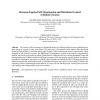123 search results - page 4 / 25 » Using structures to synchronize cameras of robots swarms |
AROBOTS
2004
13 years 5 months ago
2004
The control of robot swarming in a distributed manner is a difficult problem because global behaviors must emerge as a result of many local actions. This paper uses a bio-inspired ...
IBPRIA
2003
Springer
13 years 11 months ago
2003
Springer
This paper presents a vision-based localization approach for an underwater robot in a structured environment. The system is based on a coded pattern placed on the bottom of a water...
AAAI
2006
13 years 7 months ago
2006
NSF and NASA sponsored a workshop to discuss harvesting solar power in space. One solution considered was the use of a swarm of robots to form a solar reflector. How can these rob...
ICCV
2009
IEEE
14 years 10 months ago
2009
IEEE
This paper addresses the problem of reconstructing the 3D motion trajectories of particle swarms using two temporally synchronized and geometrically calibrated cameras. The 3D traj...
ICRA
2009
IEEE
14 years 20 days ago
2009
IEEE
— Computer vision researchers have proved the feasibility of camera self-calibration —the estimation of a camera’s internal parameters from an image sequence without any know...

